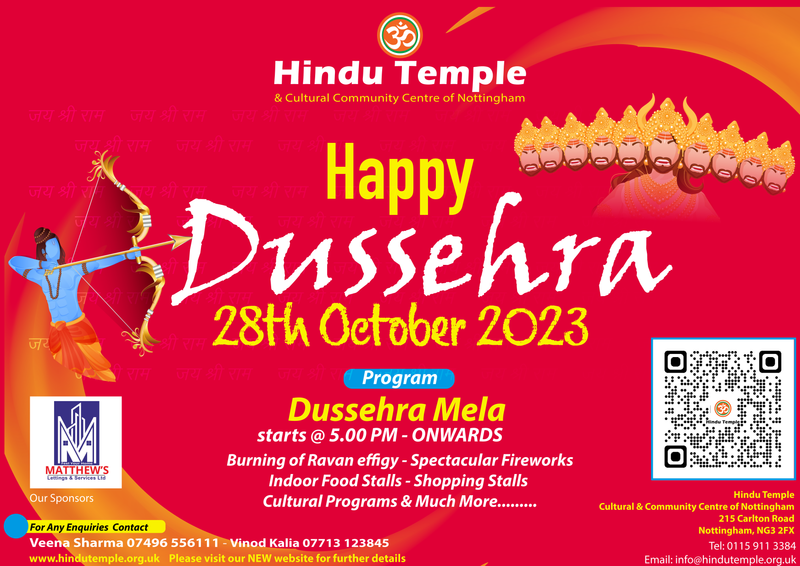Dussehra, celebrates the victory of Lord Ram over the demon king Ravana, symbolizing the triumph of good over evil. It's observed through theatrical performances, effigy burning, and worship of tools. It also marks the end of Navaratri, a festival dedicated to Goddess Durga's victory over the demon Mahishasura. Overall, Dussehra emphasizes righteousness and the importance of upholding moral values.
- Date: 28/10/2023 17:00
- Location 215 Carlton Road, Nottingham, UK (Map)
- More Info: Hindu Temple Cultural & Community Centre of Nottingham
Description
Dussehra, also known as Vijayadashami, is a major Hindu festival celebrated in India and other parts of South Asia. It holds significant cultural and religious importance for Hindus and is observed on the tenth day of the Ashwin month of the Hindu lunar calendar, which usually falls in September or October.
From a Hindu perspective, Dussehra commemorates the victory of Lord Rama over the demon king Ravana, as narrated in the ancient Indian epic, the Ramayana. The story goes that Ravana had abducted Rama's wife, Sita, and took her to his kingdom of Lanka. Rama, along with his brother Lakshmana and an army of monkeys led by Hanuman, embarked on a journey to rescue Sita.
After a long and arduous battle, Ram finally confronted Ravan on the tenth day, which is known as Dussehra. The battle concluded with Rama's arrow striking Ravan down, symbolizing the triumph of righteousness (dharma) over evil (adharma). This victory is seen as a manifestation of divine intervention and the eventual restoration of order and justice.
Dussehra is celebrated in various ways across different regions of India:
Ramlila: In many parts of India, theatrical performances known as "Ramlila" are enacted. These performances depict the life and events of Lord Ram, culminating in the final battle and victory over Ravan. The Ramlila often spans several days and involves elaborate stage setups and costumes.
Effigy Burning: One of the most prominent customs associated with Dussehra is the burning of effigies of Ravan, his brother Kumbhakarn, and his son Meghnad. This is done to symbolize the destruction of evil forces. The effigy burning is accompanied by fireworks and celebrations.
Worship of Weapons and Tools: In some regions, Dussehra is observed as Ayudha Puja, where people worship their tools, instruments, and vehicles. This is a way to acknowledge the role of these items in their livelihoods and seek blessings for their proper functioning.
Goddess Durga's Victory: In some parts of India, Dussehra also marks the end of Navaratri, a nine-night festival dedicated to the worship of the goddess Durga. Dussehra signifies the culmination of her battle against the buffalo demon Mahishasura, symbolizing the victory of good over evil.
In essence, Dussehra is a celebration of righteousness prevailing over wickedness, light overcoming darkness, and the eternal victory of virtue. It serves as a reminder of the importance of upholding moral values and standing up against injustice. The festival also holds cultural significance, fostering a sense of unity and joy among communities.



